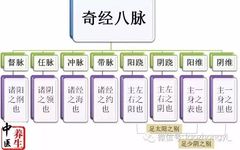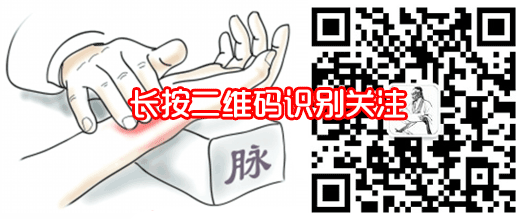
Eight Extraordinary Meridians
Traditional Chinese Medicine Health Preservation: laozhongyi_
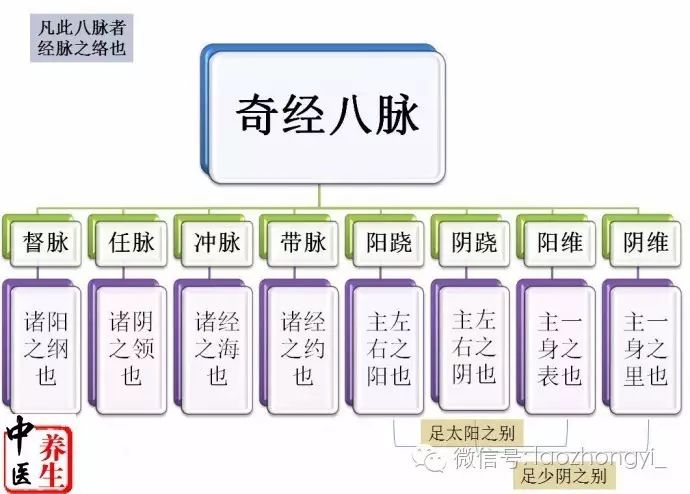
The Eight Extraordinary Meridians are a category of the body’s meridian pathways. They include the Du Mai (Governing Vessel), Ren Mai (Conception Vessel), Chong Mai (Penetrating Vessel), Dai Mai (Belt Vessel), Yang Wei Mai (Yang Linking Vessel), Yin Wei Mai (Yin Linking Vessel), Yin Qiao Mai (Yin Heel Vessel), and Yang Qiao Mai (Yang Heel Vessel). Unlike the twelve regular meridians, they do not directly connect to the organs and do not have a paired relationship, hence they are referred to as “extraordinary meridians”.
What are the Eight Extraordinary Meridians?
1. Extraordinary Meridians
The Eight Extraordinary Meridians consist of the Ren Mai, Du Mai, Chong Mai, Dai Mai, Yin Qiao Mai, Yang Qiao Mai, Yin Wei Mai, and Yang Wei Mai. They differ from the twelve regular meridians as they do not directly connect to the organs and do not have a paired relationship, thus they are called extraordinary meridians.
Functions:
1. They communicate the connections between the twelve meridians;
2. They regulate the accumulation and distribution of Qi and blood in the twelve meridians.
Eight Meridians
1. Ren Mai: It runs along the midline of the abdomen, frequently intersecting with the three Yin meridians of the hands and feet as well as the Yin Wei Mai, thus it is known as the “Sea of Yin Meridians”. The Ren Mai originates from the uterus and is related to women’s pregnancy, hence the saying “Ren governs the uterus”.
2. Du Mai: It runs along the midline of the back, frequently intersecting with the three Yang meridians of the hands and feet as well as the Yang Wei Mai, thus it is known as the “Sea of Yang Meridians”. The Du Mai runs along the spine, ascends into the brain, and branches off to connect with the kidneys, establishing a close relationship with the brain, spinal cord, and kidneys.
3. Chong Mai: It ascends to the head and descends to the feet, traversing the entire body; it serves as a crucial junction for Qi and blood, regulating the Qi and blood of the twelve meridians, hence it is called the “Sea of Twelve Meridians” and also referred to as the “Sea of Blood”. It is related to women’s menstruation.
4. Dai Mai: It originates from the lateral costal region, slants downward to the Dai Mai point, encircling the body like a belt, thus it can restrain the meridians that run vertically.
5. Yin Qiao Mai and 6. Yang Qiao Mai: The term “Qiao” implies agility and quickness. They nourish the eyes, control the opening and closing of the eyelids, and facilitate the movement of the lower limbs.
7. Yin Wei Mai and 8. Yang Wei Mai: The term “Wei” implies connection. The function of the Yin Wei Mai is to “connect the Yin meridians”; the function of the Yang Wei Mai is to “connect the Yang meridians”.
Physiological Functions of the Eight Extraordinary Meridians
1. They further strengthen the connections between the twelve meridians: for example, the Du Mai governs all Yang meridians; the Ren Mai connects all Yin meridians; the Dai Mai restrains the vertical meridians. The Yin Qiao and Yang Qiao meridians govern the Yin and Yang of the body respectively; the Yin Wei and Yang Wei meridians connect the Yin and Yang of the surface and interior of the body. Thus, the Eight Extraordinary Meridians further enhance the connections among various parts of the body.
2. They regulate the Qi and blood of the twelve meridians: when the Qi of the twelve meridians is abundant, it is stored in the Eight Extraordinary Meridians; when the Qi and blood of the twelve meridians are insufficient, the Eight Extraordinary Meridians can “overflow” to provide timely supplementation.
3. The Eight Extraordinary Meridians have a close relationship with the liver, kidneys, and other organs, as well as with the uterus in women, the brain, and the marrow, establishing certain physiological and pathological connections.
Circulation and Physiological Functions of the Eight Extraordinary Meridians
(1) Circulation and Physiological Functions of the Du Mai
1. Circulation Path: The Du Mai originates from the lower abdomen, exits at the perineum, travels to the tailbone at the Changqiang point, ascends along the spine, passes through the nape to the Fengfu point, enters the brain, belongs to the brain, ascends along the midline of the head to the Baihui point, descends through the forehead to the tip of the nose at the Suliao point, passes through the philtrum, and reaches the center of the upper gums at the Yinjiao point.
2. Branches: The first branch originates with the Chong and Ren meridians from the uterus, exits at the perineum, and meets the Kidney meridian and Bladder meridian at the tailbone, connecting with the kidneys. The second branch ascends directly from the lower abdomen through the navel, travels upward to the throat, where it meets the Chong and Ren meridians, and then encircles the lips, reaching the center below the eyes. The third branch originates from the inner canthus of the eye, ascends to the forehead, meets at the top of the head, connects with the brain, and then branches down the back of the neck, along the inner scapula, beside the spine, reaching the waist, and enters the muscles on both sides of the spine, connecting with the kidneys.
3. Physiological Functions
(1) Regulates the Qi and blood of the Yang meridians, serving as the “Sea of Yang Meridians”: The Du Mai runs along the back, which is Yang, indicating that it has a commanding and supervising role over the Qi of all Yang meridians. Additionally, all six Yang meridians intersect with the Du Mai at the Dazhui point, thus it has a regulatory effect on the Yang meridians, hence the saying “governs all Yang meridians”.
(2) Reflects the functions of the brain, kidneys, and spinal cord: The Du Mai belongs to the brain and connects with the kidneys. The kidneys produce marrow, and the brain is the sea of marrow. The relationship between the Du Mai and the brain, kidneys, and spinal cord is very close.
(3) Governs reproductive functions: The Du Mai connects with the kidneys, and since the kidneys govern reproduction, the Du Mai is related to reproductive functions.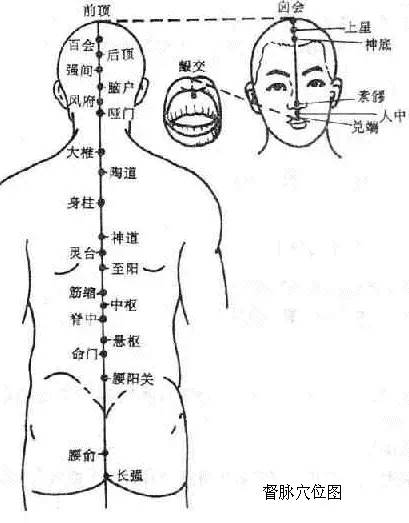
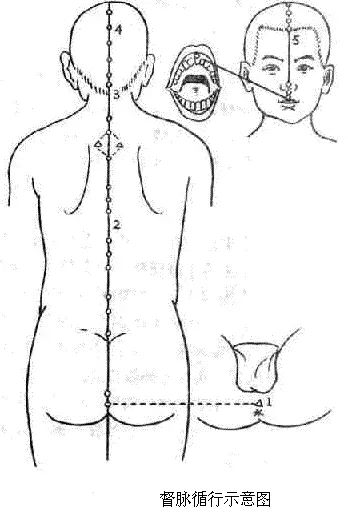
(2) Circulation and Physiological Functions of the Ren Mai
1. Circulation Path: The Ren Mai originates from the uterus, exits at the perineum, travels through the Yin mound, ascends along the midline of the abdomen, passes through the throat (Tiantu point), reaches the inner lower lip, branches left and right, encircles the lips, meets the Du Mai at the Yinjiao point, and then passes through the sides of the nose, ascending to the lower eye socket (Chengqi point), where it intersects with the Yangming meridian of the foot.
2. Branches: It travels from the uterus along the spine, ascending along the back.
3. Physiological Functions
(1) Regulates the Qi and blood of the Yin meridians, serving as the “Sea of Yin Meridians”: The Ren Mai runs along the midline of the abdomen, which is Yin, indicating that it has a commanding role over the Qi of all Yin meridians. Additionally, the three Yin meridians of the foot intersect with the Ren Mai in the lower abdomen, and the three Yin meridians of the hand connect with the Ren Mai through the three Yin meridians of the foot, thus the Ren Mai has a regulatory effect on the Yin meridians, hence the saying “governs all Yin meridians”.
(2) Regulates menstruation and nourishes the fetus: The Ren Mai originates from the uterus, thus it has the function of regulating menstruation and promoting women’s reproductive functions, hence the saying “Ren governs the uterus”.
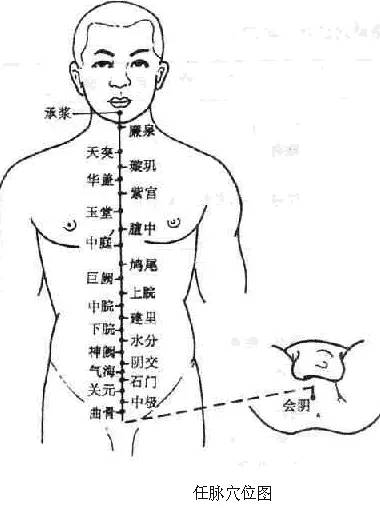
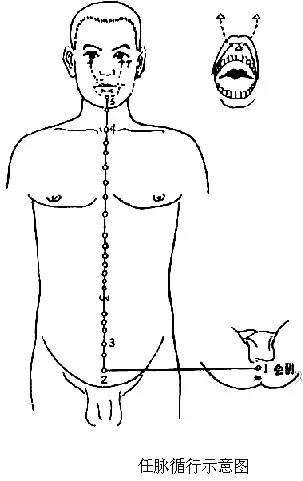
(3) Circulation and Physiological Functions of the Chong Mai
1. Circulation Path: It originates from the uterus, exits at the perineum, and divides into two branches. The ascending branch (the main part of the Chong Mai) runs along the anterior abdominal wall, near the navel (five fen from the navel), ascends, connects with the Kidney meridian, spreads in the chest, and then ascends through the throat, encircling the lips; the descending branch runs along the posterior abdominal wall, ascending within the spine. The descending branch exits the perineum and descends along the inner thigh to the space between the big toe.
2. Physiological Functions
(1) Regulates the Qi and blood of the twelve meridians: The Chong Mai ascends to the head and descends to the feet, traversing the entire body, serving as a crucial junction for the Qi and blood of all meridians. When the Qi and blood of the meridians and organs are abundant, the Chong Mai can store and accumulate them; when they are insufficient, the Chong Mai can provide infusion and supplementation to maintain the normal physiological activities of the body’s tissues and organs. Hence, it is referred to as the “Sea of Twelve Meridians”, “Sea of Five Zang and Six Fu”, and “Sea of Blood”.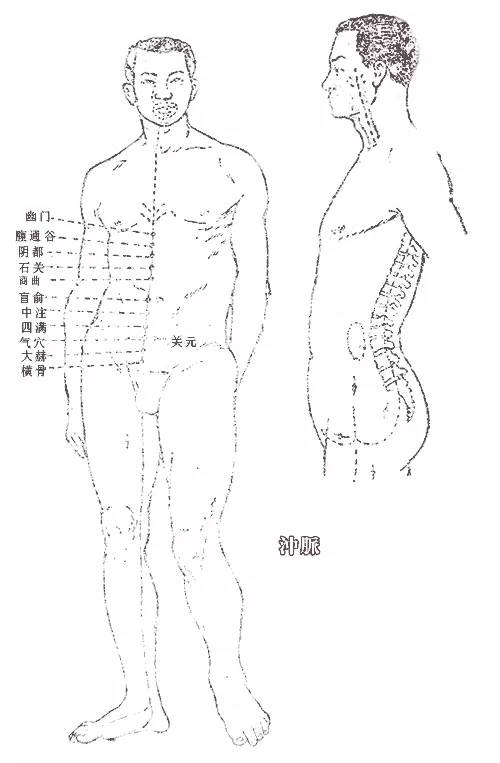
(2) Governs reproductive functions: The Chong Mai originates from the uterus, also known as the “Blood Chamber” or “Sea of Blood”. It has a role in regulating menstruation. The Chong Mai is closely related to reproductive functions; for women, “when the Chong Mai is abundant, menstruation occurs regularly, leading to conception”. Conversely, if the Chong Mai is deficient, it can lead to reproductive dysfunction.
(3) Regulates the ascending and descending of Qi: The Chong Mai connects with the Kidney meridian, belongs to the Yangming, and connects with the Jueyin and Taiyang. The Chong Mai has the function of regulating the ascending and descending of Qi in certain organs (mainly the liver, kidneys, and stomach).
(4) Circulation and Physiological Functions of the Dai Mai
1. Circulation Path: The Dai Mai originates from the lateral costal region, slants downward, intersects with the Dai Mai point of the Gallbladder meridian of the foot, encircles the body, and then descends forward along the upper edge of the hip bone to the lower abdomen.
2. Physiological Functions: It restrains the vertical meridians and governs women’s leukorrhea.
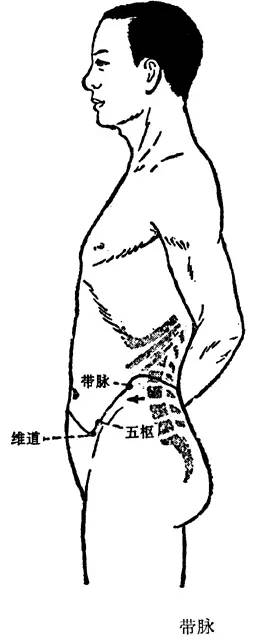
(5) Circulation and Physiological Functions of the Yin Qiao Mai
1. Circulation Path: The Yin Qiao Mai originates from the inner side of the heel of the foot, at the Zhaohai point of the Kidney meridian, ascends through the inner ankle, along the inner thigh to the anterior genital area, ascends along the anterior surface of the trunk to the chest, enters the Xuepen, ascends beside the Adam’s apple to the Ren Mai’s Tian Tu point, reaches the side of the nose, connects with the inner canthus of the eye, and ascends along with the Yang Qiao and Taiyang meridians.
2. Physiological Functions: It controls the opening and closing of the eyes and the movement of the muscles.

(6) Circulation and Physiological Functions of the Yang Qiao Mai
1. Circulation Path: The Yang Qiao Mai originates from the outer side of the heel of the foot, at the Shenshu point of the Bladder meridian, ascends along the outer ankle, travels up the outer edge of the lower limb to the abdomen. It runs along the posterior outer side of the chest, through the shoulder, along the outer side of the neck, ascends to the corner of the mouth, reaches the inner canthus of the eye, connects with the Yang Qiao and Taiyang meridians, and ascends along the Bladder meridian to meet the Shaoyang meridian at the Fengchi point behind the neck.
2. Physiological Functions: It controls the opening and closing of the eyes and muscle movement.

(7) Circulation and Physiological Functions of the Yin Wei Mai
1. Circulation Path: The Yin Wei Mai originates from the five cun above the inner ankle of the foot, at the Zhubin point of the Kidney meridian, ascends along the inner edge of the lower limb to the abdomen, travels with the Taiyin Spleen meridian to the lateral costal region, connects with the Jueyin Liver meridian, ascends to meet the Tian Tu point of the Ren Mai, and terminates at the Lianquan point in the throat.
2. Physiological Functions: The term “Wei” implies connection. The Yin Wei has the function of connecting the Yin meridians.
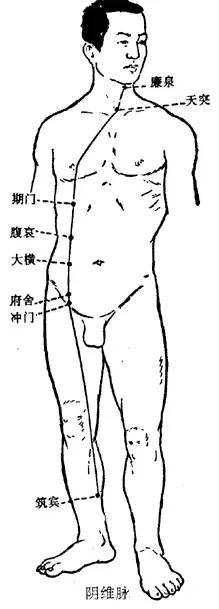
(8) Circulation and Physiological Functions of the Yang Wei Mai
1. Circulation Path: The Yang Wei Mai originates from the Jinmen point of the Bladder meridian, passes over the outer ankle, ascends along the outer edge of the lower limb, travels along the posterior outer side of the trunk, from the back of the armpit over the shoulder, through the neck, to the forehead, distributing over the side of the head and the back of the neck, connecting with the Du Mai.
2. Physiological Functions: It connects the Yang meridians.

Get more content by replying with any of the following keywords:
Nourishing the Stomach, Qi and Blood Deficiency, Hypertension, White Hair, Foot Soaking, Hair Loss, Coix Seed, Anemia (Blood Supplement), Pharyngitis, Nourishing the Stomach, Bathing, Oral Ulcers, Bad Breath, Cold Uterus, Efficacy of Coix Porridge, Regulating the Spleen and Stomach, Cold, Cough, Insomnia, Sensitivity to Cold, Cold Hands and Feet, Low Back Pain, Sore Throat, Eliminating Dampness, Nourishing the Kidneys, Height and Weight Chart, Vegetable Pairing Taboo, Sleeping Naked, Finger Massage, Acne, Cervical Spondylosis, Cardiovascular Diseases, Spot Removal, Blood Supplement, Slimming Legs, Safe Period, Breast Self-Examination, Body Cold, Dysmenorrhea, Weight Loss, Sexual Health Issues, Endocrine Issues, Gynecological Issues, Health Tests, Constitution Tests, Standard Three Measurements Test (Three Measurements), Body Mass Index Self-Test, Standard Weight
Diagnosis: Hand Diagnosis, Tongue Diagnosis, Observation Diagnosis
Acupuncture Points: Shen Yu Point, Jing Ming Point, Eye Acupuncture Point Map, Eye Acupuncture Points, Zu San Li Point, Yun Men Point, Jie Xi Point, Tian Zhu Point

